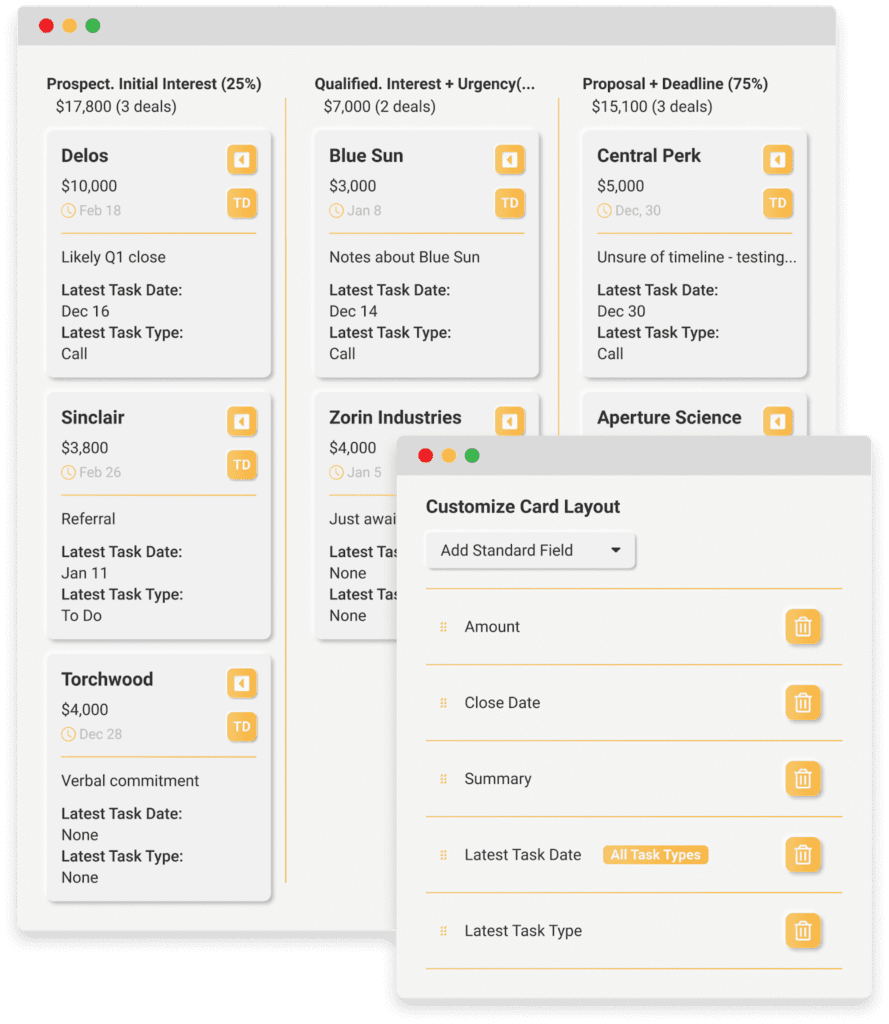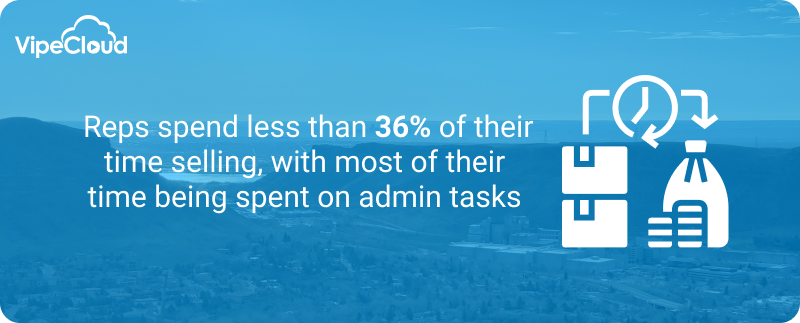Last updated on August 3rd, 2023
Don’t miss this guide on opportunity management. We outline ways to make the most out of your deals so that fewer fall through the cracks.
The better you can manage potential deals, the higher your likelihood of:
- converting prospects into paying clients
- Upselling clients to more premium services
- Cross-selling clients to complimentary services
Managing sales opportunities via spreadsheets, or even worse, word of mouth is a costly mistake.
Because here’s the deal:
If you’re not currently using a structured opportunity management process, money is being left on the table.
Table of Contents:
- What Is The Opportunity Management Process?
- Why Is Opportunity Management Important?
- What Are The Components Of Opportunity Management?: 5 Must-Have Elements
- How Can Opportunities Be Organized Using A Sales Pipeline?
- What Other CRM Features Help Improve Opportunity Management?
- What Are Best Practices When Managing Deal Opportunities?
- What Is The Best Tool To Manage Pipeline Opportunities?
 Automate All Your Communications With VipeCloud
Automate All Your Communications With VipeCloud
VipeCloud is the only Automation tool your small business needs to
be the hero to your customers.
With Email, Texting, Social, Suites, Chat, Stories, Video Email & Sign Up Forms fully built-in, we provide you with the perfect platform to grow your business.
15 Day Free Trial – Get started risk free. No CC needed.
What Is The Opportunity Management?
In B2B, opportunity management is the process that directs pipeline deals to a close.
(Or, in some cases, at least maintain them in the sales pipeline.)
Having a thorough opportunity management process means knowing:
- Who your ideal customers are
- How they buy
- Your sales cycle stages
- Your sales cycle timeframe
- Ideal prospect communication channels
- How to organize deal information
With these factors implemented, opportunity management becomes easier, and a lot of it starts with your CRM pipeline.
Why?
A CRM pipeline lets you visualize your opportunities, their information, tasks, and internal activity in one dashboard.
The result is easier management, more effective selling, and a big decrease in missed opportunities.
You can customizee your pipeline to represent the stages of your sales process and the deal information you care about.
Lastly, you can edit your pipeline’s close probability percentages which show the likelihood of your deals closing (ex. 25%, 50%, 75%, 90%, 100%).
This helps sales managers forecast future deals.
Why Is Opportunity Management Important?
More Revenue From Won Deals
When you manage your leads better, you increase sales effectiveness.
Having deal information like a decision-maker’s goals in your discovery notes attached to an opportunity, you’ll be able to sell the lead based on what they want.
Or when a prospect asks for specific action items from you to move the deal forward, you can add those next steps directly to the opportunity.
In other words, opportunity management should help reps never miss a beat on what they need to close a prospect.
Repeatable Steps To Success
Knowing how to manage your opportunities gives your team repeatable steps to success.
For example, they might know when to send specific sales whitepapers based on where prospects are in your pipeline and when to complete certain tasks.
Repeatable systems help you scale your team and revenue.
Deal Clarity Across The Organization
Well-managed opportunities let your team see all your deals with detailed information.
This can be helpful if your AE’s sell in teams or if a sales specialist joins and needs to be brought up to speed.
In addition, managers can reduce back-in-forth communications thanks to the big-picture and contextual deal information on your pipelines.
Opportunity For Higher Customer Lifetime Value (CLV)
Better opportunity management can happen by using separate pipelines.
For example, with VipeCloud, you can create account management pipelines for client management and upselling.
Knowing when a customer is ready for a particular upsell can lead to more revenue without even acquiring a new customer.
5 Must-Have Components Of Successful Opportunity Management
1. Consistent Lead Generation
Your opportunities start at the top of your sales funnel, aka at lead generation.
Your form of lead generation (whether organic or paid traffic and inbound or outbound) must consistently bring in interested prospects.
Here are 6 ingredients to keeping lead volume consistent:
1. Establishing product-market fit
2. Marketing where your audience hangs out
3. Speaking to their pain points and desired outcomes in your marketing
4. Having an enticing offer (discounts, free trials, bonuses, etc.)
5. Driving action with a CTA
6. Giving a solid guarantee (taking the “risk” off your customer’s hands)
Only a minority of prospects will be ready to buy or qualified to do so, once they’re in your pipeline.
The discovery stage of your sales is where you distinguish your critical opportunities.
2. A CRM Pipeline
Next, your CRM pipeline is a foundational tool to ensure deals are well organized.
As a key component for deal management, your pipeline lets you associate tasks with different deals, bringing optimal turnaround time.
Having tasks with deadlines for things like communications and contract preparation is what helps reduce a drawn-out buying process.
And shorter sales cycles increase the likelihood of a deal closing.
3. Reporting Tools
Reporting tools offer metrics on how sales reps and teams as a whole are performing.
Deal opportunities will often require follow-ups and conversations on different communication platforms.
For instance, a rep could use email to share information with a CFO and text messaging for shorter information.
Your CRM reporting dashboard keeps track of these touchpoints as well as:
- How many tasks reps have completed
- How many opportunities reps have on their individual pipeline
- Email engagement – ex. number of clicks on sent emails
- Recurring revenue
With reporting tools, sales leaders can make better decisions based on factual information regarding their opportunities and rep performance.
4. Task Management
As I mentioned earlier, tasks help with keeping deal momentum by establishing due dates for essential sales tasks.
With VipeCloud, tasks can be categorized by type, like to-do lists, phone calls, etc., and you can create custom types to match the unique task categories of your organization.
Establishing recurring tasks maintains sales team productivity and can save managers ample time.
5. Communication Channels
The prospects in your opportunities may come from multiple communication channels.
So it only makes sense to meet your prospects where they are most. Start with CRM to take advantage of email, text, and social media capabilities for your touchpoints and engagements.
Additionally, you can create automation campaigns which will save you time.
How Can Opportunities Be Organized Using A Sales Pipeline
1. Make Pipeline Stages Reflect Your Sales Process
You can begin by naming your pipeline stages based on your unique sales process.

Think about the significant stages in making a prospect a customer but also consider what actions sales reps take in those stages.
For example, maybe you’ve found success when a rep sends a customer testimonial (action) after a discovery call (stage). You figured out that this warmed prospects up and increased their likelihood of converting the sales calls.
As mentioned earlier, customizable CRMs allow you to assign probability percentages to each stage.
Since more prospects fall off the deeper you go into the funnel, the likelihood of those still in the pipeline converting increases.
A simple example of percentages by stage can look like this:
Example: Prospect 25%, Qualified (sal 5es meeting)0%, Proposal 75%, closed/won 100%
2. Create Opportunity Cards With Detailed Information
Opportunity cards house the information about your different deals.
They can include:
- Names
- Deal size
- Contextual notes on your opportunities
- Latest tasks type
- Latest task date
Information like this keeps teams on the same page by having contextual information about each deal.
3. Display The Right Deal Information
Did you know that your pipeline cards can be customized?

You can select which information to display and which ones to not.
If you’re running a very small sales team, you may want to display the deal name and size.
On the other hand, if your team is sizable, maybe showing a deal summary and the latest completed tasks would make keeping up with your deals easier.
4. Keep Deal Information Updated
New information presents itself constantly in each of your deals.
For that reason, AEs should keep the information updated after sales calls, email and text communication, and even buyer behavior.
And by buyer behavior, I mean how buyers engage with sales materials and how they communicate.
New information can also be logistical information, like when a decision-maker will be available.
5. Create Multiple Pipelines
Just because an opportunity is won doesn’t mean there isn’t more value to bring to your customer.
In fact, you’ve often only scratched the surface of what a customer could be investing.
For this reason?
Think of creating multiple pipelines, with one of them being dedicated to account management.
Fortunately, VipeCloud lets you do just that, so you can track customer accounts and identify upselling opportunities.
For instance, account managers can check in periodically and upsell additional add-ons, which can drive up account value (as they answer customer inquiries and solve problems).
Furthermore, your account management pipeline can have categories (or stages) based on the product or service your customer is using.
When they’re ready for service add-ons, you can move them to a column that has the new add-on listed.
The takeaway is simple — you’re managing your customers better while giving your organization room to raise account value.
What Other CRM Features Help Improve Opportunity Management?
Here are additional features (besides the CRM pipeline) that improve your ability to manage your deals.
- Contact scoring – contact scoring lets you assign values to each prospect so you can focus on and manage your most qualified leads. (This helps you weed out the deals that aren’t a good fit based on explicit and implicit information).
- Email integrations – email integrations can sync people from your email communications into your CRM database, making it more seamless to create new contacts and assign them to a deal.
3 Best Practices When Managing Deal Opportunities
Automate The Repetitive Stuff
CRM entry, manual follow-up (email, SMS), lead qualification, and lead distribution can get repetitive.
And too many manual tasks can take time away from more selling.

Reps spend less than 36% of their time selling, with most of their time being spent on admin tasks.
This can get problematic.
So here’s how to automate four tedious yet essential tasks:
- CRM entry – data syncing
- Manual follow-up – email, text automation drip campaigns
- Lead qualification – contact scoring
- Lead distribution – lead distribution software
Disqualify Unfit Buyers
Most prospects aren’t qualified to buy from you, and in many cases, it’s the overwhelming majority.
For this reason, you MUST disqualify some prospects so that your sales cycle stays efficient.
You can go about this in multiple ways, but one of the best means is fusing a sales methodology framework with a tool like contact scoring.
We’ve covered contact scoring’s value when segmenting who’s an ideal buyer, but what is a sales methodology framework?
It’s simply the steps you take to qualify prospects and sell your offer.
One of the most popular frameworks is BANT, which stands for budget, authority, need, and timeline.
- Can they afford your solution?
- Do they have the organizational authority to make a decision?
- Do they need your offer?
- Is their timeline in the present or reasonably in the future?
Use A Top Rated, All-In-One CRM
A top-rated CRM comes with the tools that make opportunity management easier.
Top CRM companies offer helpful support for navigating their tools via experts, documentation, blogs, and other educational material.
Well-established CRMs also prioritize the user experience and invite feature recommendations that can potentially improve how you manage deals.
So that leaves the question:
What Is The Best Tool To Manage Pipeline Opportunities?
If you’re on the hunt for a CRM that makes managing opportunities less of a chore, look no further than VipeCloud.
VipeCloud’s all-in-one CRM is the top-rated tool, thanks to its sales and marketing versatility.
Take advantage of pipeline management, contact scoring, reporting, task management, and more to make the most of your opportunities.
Have questions about how it works?
Feel free to request a demo, and an expert will walk you through the features.
If you’re ready to try out the CRM pipeline and other features, get it now free for 15 days!

Leave a Reply